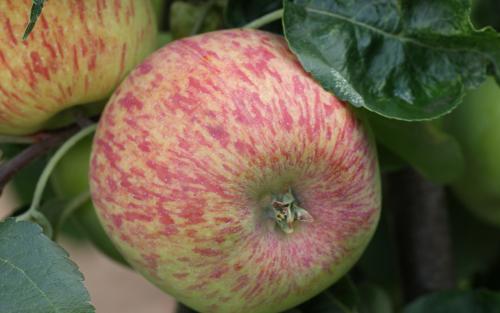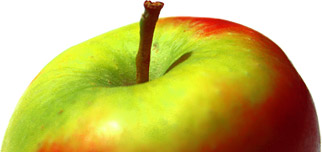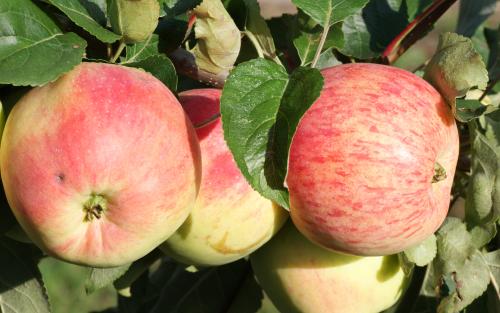
Duchess of Oldenburg is a very attractive early-season apple, originating from Russia in the early 18th century. It is primarily used as a cooking apple.
Although never really a commercial variety, it was quite widely grown across northern Europe in the 19th century. It was imported to the USA in 1835 by the Massachusetts Horticultural Society, and its excellent cold hardiness made it a popular variety in the northern states.
From the 1920s Duchess of Oldenburg became an early mainstay of the University of Minnesota's (UMN) long-running and well-respected cold-hardy apple breeding program. The true extent of its role was not apparent because of errors in written records of parentage, but recent DNA testing by Luby, Howard, Tillman and Bedford at UMN, found that Duchess of Oldenburg was present in the ancestry of almost every apple variety ever developed at UMN.
Also known as
- Borowinka
Duchess of Oldenburg apple identification images
All images copyright Orange Pippin unless otherwise stated.
USDA identification images for Duchess of Oldenburg
The identification paintings in the USDA Pomological Watercolor Collection span the years 1886 to 1942.
Citation: U.S. Department of Agriculture Pomological Watercolor Collection. Rare and Special Collections, National Agricultural Library, Beltsville, MD 20705.
Offspring of this variety
- Alkmene
- Beacon(distant descendant)
- Erwin Bauer
- Evelina(distant descendant)
- Frostbite(distant descendant)
- Hazen
- Honeycrisp(distant descendant)
- Northern Spy(distant descendant)
- Red Baron
- Red Windsor
Visitor reviews
- 16 Apr 2021 NEW YORK, United StatesGreat for cooking, not fresh eating. Extremely tart, with very little sweetness, and little juice. A soft, very early apple that only keeps a few weeks in cold storage, or literally just a few days at room temp. They are like no other apple I’ve ever tried, and have been growing them for 15 years. Tree is hearty, and has large crops every year. I disagree with others on a few points, as there might possibly be differences between individual trees, but there is no way these can be eaten fresh. They are simply too tart with very little sweetness, and soft texture. They are fantastic for drying, baking, and pies/sauces. The apple is soft, and mealy a day or two after ripe, and some report that they turn to mush in a pie, but I have had the opposite experience. Even though they are soft, they retain their shape and definition quite well in a pie, and their tart flavor profile in this usage is stunning. They are highly recommended, as long as you careful picking them within the right harvest window.
- 07 Jun 2019 MI, United StatesI have 2 Duchess trees in my home orchard..This is one apple that if picked before it is ripe wouldn't be good for fresh eating..Allow it to fully ripen before fresh eating..Large apples every year on my trees..Good for fresh eating and excellent for cooking..
- 05 Aug 2014 BRITISH COLUMBIA, CanadaOur tree is quite old - our guess is it is at least 80+ years old. It produces upwards of 600+ pounds in a good year and 300+ pounds in a dry Summer. The apples are excellent for eating and apple sauce, as they break down too readily in pies.
- 06 Aug 2013 United StatesWe harvested 7-10 bushels of Duchess. I would use one word to describe the apple: Tart. I usually like tart apples, but Duchess is simply too tart.
- 17 Jun 2012 WA, SPOKANE COUNTY, United StatesThis is a good keeper in cold storage. Ours was good for cooking up until March this year 2012. When I use it for pie or apple crisp I like to add a little lime juice for tartness. Overall mild sweet taste.
Tree register
United States
- Aaron Millis in HELENA, MT
- Amanda Emily in Colville, STEVENS, WA
- Andrew Plumer in Ashfield, MA
- Andrew Plumer in Ashfield, MA
- Barbara Silas in Poulsbo, WA
- Becky Liegl in Waupaca, WI/WAUPACA
- Brian Van Erem in Green Bay, WI
- Carla Zimmerman in Oneida, WISCONSIN
- Charley in Spokane, WA, SPOKANE COUNTY
- Colleen Dodge in Crystal Lake, IL
- Corey Wilcox in Richfield, WI
- David H. Daugherty, Jr. in Rochester, MN,OLMSTED
- David H. Daugherty, Jr. in Rochester, MN,OLMSTED
- David Shaffer in Harrod, OH
- Dianne Giles in Henderson, IOWA
- Esther Rogers Baker in Saranac Lake, NY
- James Roden in Estacada, OR
- Jeremy And Sarah Coke in Wasilla, ALASKA
- Jeremy And Sarah Coke in Wasilla, ALASKA
- Jeremy And Sarah Coke in Wasilla, ALASKA
- Jeremy And Sarah Coke in Wasilla, ALASKA
- Jesse in Kernersville, NC
- Joel Howie in Canton, NEW YORK
- John in Edgerton, WISCONSIN
- John Buckwalter in Alfred Station, NY / ALLEGANY
- Julie Sawtelle in Monmouth, ME
- Kent Montgomery in Brainerd, MINNESOTA / CROW WING
- Kim Lapacek in Poynette, WI
- Lyn.Whitman@Outlook.Com in La Barge, WY
- Mark A. Rock in Columbia Station, OHIO
- Michael Miller in Kennett Square, PA
- Michelle Smith in Skye Glen, NOVA SCOTIA
- Mike Mades in Westfield, WI
- Nathan Parker in Mount Shasta, CA
- Rick Simoniello in Storrs / Mansfield, CT
- Ronald J. Knutson in Eau Claire, EAU CLAIRE, WI
- Thomas Griffith in Cottage Grove, WI
- Velvie Mckenzie in Jackson, OH
United Kingdom
- Connor in Southampton,
Canada
- Charlie Zinkan in Nelson, BRITISH COLUMBIA
- Janet Van Camp in Blackstock, ONTARIO
- Michael Hovey in Miramichi, NEW BRUNSWICK
- Nancy Wilson in Peterborough, ONTARIO ,
- Stella Hiemstra in Inverary, ONTARIO
New Zealand
- Giles in HAMILTON, WAIKATO
Spring blossom records for this variety
2014 season
- 15th May 2014 - tree owned by Thomas in Cottage Grove, United States
2012 season
- 9th May 2012 - tree owned by James in Estacada, United States
Record your blossom dates in our Fruit Tree Register - more >>.
Harvest records for this variety
Origins
- Species: Malus domestica - Apple
- Originates from: Russia
- Introduced: 18th century
- UK National Fruit Collection accession: 1957-190
- We are grateful to Brogdale Farm - home of the UK National Fruit Collection - for providing samples of this variety.
- Some historical details taken with kind permission from 'The New Book of Apples' by Joan Morgan and Alison Richards , illustrated by Elisabeth Dowle, published by Ebury Press, 2002.
Identification
- Country of origin: Russia
- Period of origin: 1750 - 1799
- Flower colour: White
- Leaf colour: Green
- Popularity: Rarely grown
- Annual cycle: Deciduous
Using
- Picking season: Early
- Keeping (of fruit): 1 week
- Flavour quality: Good
- Flavour style (apples): Sharper
- Cooking result: Puree
- Discoloration of fruit: Oxidising
- Juice style: Sharper
- Cropping: Heavy
- Fruit persistence: Normal ripening
- Food uses: Culinary
- Food uses: Traditional cooker
- Picking period: mid-August
- Wildlife: RHS Plants for Pollinators
Growing
- Gardening skill: Beginner
- Flowering group: 2
- Pollinating others: Average
- Ploidy: Diploid
- Vigour: Average vigour
- Precocity: Precocious
- Bearing regularity: Regular
- Fruit bearing: Spur-bearer
- Attractive features: Attractive fruit
- Self-fertility: Not self-fertile
Climate
- Frost resistance of blossom: Good resistance
- Cold hardiness (USDA): Zone 3 (-40C)
- Climate suitability: Temperate climates
- Cold-hardiness: Cold-hardy
- Summer average maximum temperatures: Cool ( 20-24C / 68-75F)
- Summer average maximum temperatures: Warm (25-30C / 76-85F)
- Summer average maximum temperatures: Cold (< 20C / 67F)
Other qualities
- Disease resistance: Good
- Scab (Apple and Pear): Some resistance
- Powdery mildew: Some resistance
- Cedar apple rust: Some resistance
- Fire blight: Some susceptibility
Where to buy trees
The following tree nurseries offer Duchess of Oldenburg apple trees for sale:
- Orange Pippin Fruit Trees (USA) United States
Duchess of Oldenburg apple trees
Where to buy fresh fruit
The following orchards grow Duchess of Oldenburg:
United States
Illinois
- Homestead Orchard, Woodstock
Iowa
- Apples on the Avenue, Nashua
- Deal's Orchard, Jefferson
- East View Orchard, Fredericksburg
- Wilson's Orchard, Iowa City
Maine
- North Chester Orchard, Chester
- Sweetser's Apple Barrel and Orchards, Cumberland Center
Massachusetts
- Brook Farm Orchard, Ashfield
- Clarkdale Fruit Farms, Deerfield
- Red Apple Farm, Phillipston
Minnesota
- Aamodt's Apple Farm and Bakery, Stillwater
- Maple Hills Orchard, Frazee
- Sekapp Orchard, Rochester
- Sweetland Orchard, Webster
- Two Fruit's Fruits, Hinckley
Montana
- Bluewater Orchard, Fromberg
New Hampshire
- Alyson's Apple Orchard, Walpole
North Carolina
- Big Horse Creek Farm, Lansing
Ohio
- Ochs Fruit Farm, Lancaster
Washington
- Piper's Orchard, Seattle
Wisconsin
- Door Creek Orchard, Cottage Grove
- Silver Creek Orchards, Merrill
Canada
British Columbia
- Apple Luscious Organic Orchards, Salt Spring Island
- Salt Spring Apple Company, Salt Spring Island
Ontario
- O'Keefe Grange, Dobbinton
References
- Apples of England (1948)
Author: Taylor


